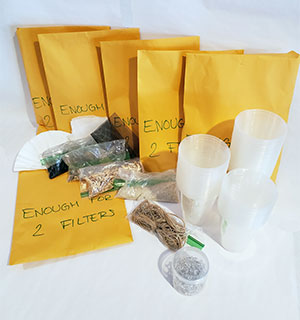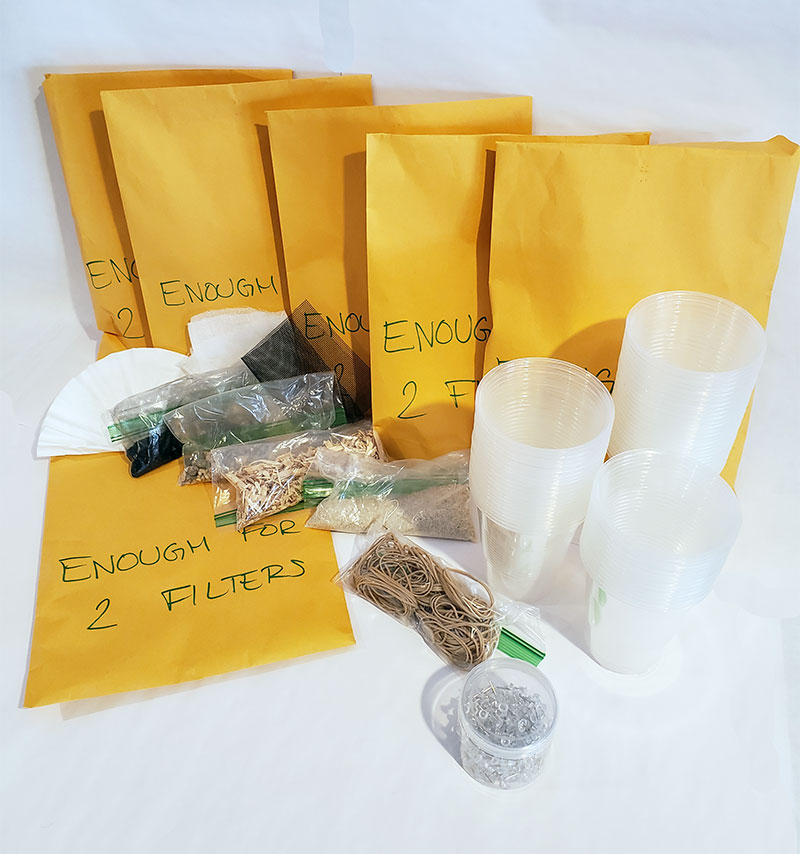Lesson 6: The Earth Filters the Water
The Environmental Protection Agency (EPA) states, “About half of our nation’s drinking water comes from groundwater, and most are supplied through public drinking water systems.” In Pennsylvania, there are approximately one million private household wells that use groundwater as their source of freshwater; in Virginia, this number is 1.6 million. Is well water safe to drink? Often the answer is yes.
Infiltration is the process by which the Earth naturally filters water. Rain falls on the Earth’s surface; if it falls on a pervious surface, it seeps into the ground. This is where the infiltration process starts to “clean” the water! The soil particles and vegetation covering the soil influence how fast water infiltrates. Soil pores (or gaps) exist between particle types and are occupied by water and air. Water travels through these pores and soaks deeper into the ground through layers of humus (organic debris such as twigs and leaves), surface soil, subsoil, gravel, sand, and other particles, creating a macropore filtration system that cleans the water before it enters groundwater storage areas called aquifers that are essential resources for drinking water. In this lesson, students will engage in an engineering activity where they are challenged to build a stackable filter to clean dirty water using the Earth's process of infiltration as a model.
Materials:
Materials provided in the Lesson 6 kit:
- Activity 1: N/A
- Activity 2: Materials (per group): 7 clear plastic cups, Pushpins (30 or so), 2 Coffee Filter, 5-10 Rubber bands, Cheesecloth (1 sq ft or so), pool filter sand (~ ⅓ cup), activated aquarium filter charcoal (~ ⅓ cup), gravel (~ ⅓ cup), shaved pine bedding (~ ½ cup) fiberglass screen (~4in sq)
Materials you will need to gather:
- Lesson 6 slide show
- Activity 1: N/A
- Activity 2: ~1 gallon of dirty water made by adding dirt, sticks, leaves, and debris to the water.
- Activity 2: Make one copy of the Engineering Design Process handout per student. Paper towels for cleanup.
Learning Objectives:
At the completion of the lesson, students will be able to:
- Describe the process of infiltration and its role in how the Earth filters water
- Design a model of Earth’s process of cleaning water via infiltration
Activities:
Begin the class by asking students where our school’s drinking water comes from. For instance, Millersville University’s drinking water is from the Lancaster City Department of Public Works. Tell students the water is safe to drink at school, whether our water comes from a municipal water company or a well at school. In the PowerPoint presentation, show students the image of the Water Well. Ask them where groundwater comes from. Groundwater is replenished from rain that infiltrates into the ground. The layers of soil clean the water as the water infiltrates into the ground. Show the image of the soil column. Discuss how the layers of soil can clean the water.
*adapted from Engineering a Model of the Earth as a Water Filter
Now, pose the engineering challenge. Tell students that today, they will build a water filter to clean dirty water using the soil layers as a model! Show the Design slide of the PowerPoint presentation.
 Students will work in groups; give each group a set of materials. The kit has many materials that students can use, mix, modify, and add to each cup. Have the students explore the materials together and think about how to order the materials in their filter to mimic the soil layers. There are enough materials for the student to make 2 filters. This will let them build a filter, test it, and re-design it for another trial. (Remind students only to use half of the materials in the cups in the first design. They need to save half of the materials for their second trial, where they improve their initial design.)
Students will work in groups; give each group a set of materials. The kit has many materials that students can use, mix, modify, and add to each cup. Have the students explore the materials together and think about how to order the materials in their filter to mimic the soil layers. There are enough materials for the student to make 2 filters. This will let them build a filter, test it, and re-design it for another trial. (Remind students only to use half of the materials in the cups in the first design. They need to save half of the materials for their second trial, where they improve their initial design.)
To build the stackable water filter, students will take 5 cups and use the push pin to punch holes in the bottom of each cup so the water can pass through. The sixth cup will be used to collect the water, and it represents the bedrock. Have students use push pins on the side of each cup to create the stackable filter.
Students will pour a cup of dirty water into their filters to test the filter’s ability to clean the water.
Encourage students to redesign and try it again if time allows.At the end of class, ask students why infiltration is better for the watershed than runoff.
CALL TO ACTION - Ask students, “Think about the walk around the schoolyard we did where we identified pervious and impervious surfaces. What changes can WE make to the schoolyard to increase infiltration and reduce runoff?"
Possible Extension:
You can save the students filtered water and use the lesson 7 supplies to test the chemistry of this water.
Possible Differentiation Adaptations:
For groups that struggle with fine motor skills, you can provide them with stackable cups that already have the holes poked on the bottom and the pushpins placed on the sides. With these modifications, students only need to design the layers and add the chosen materials to each layer.
Assessment:
Have students compare the original water to the filtered water.
- Did the filter you created help to clean the water?
- Is the water safe to drink? (The answer is NO! There could be chemicals dissolved in the water that we cannot see and won’t be removed by the filter. We will test for chemicals in the water in lesson 7).
- Why is it important to design the land so that we encourage infiltration instead of runoff?

